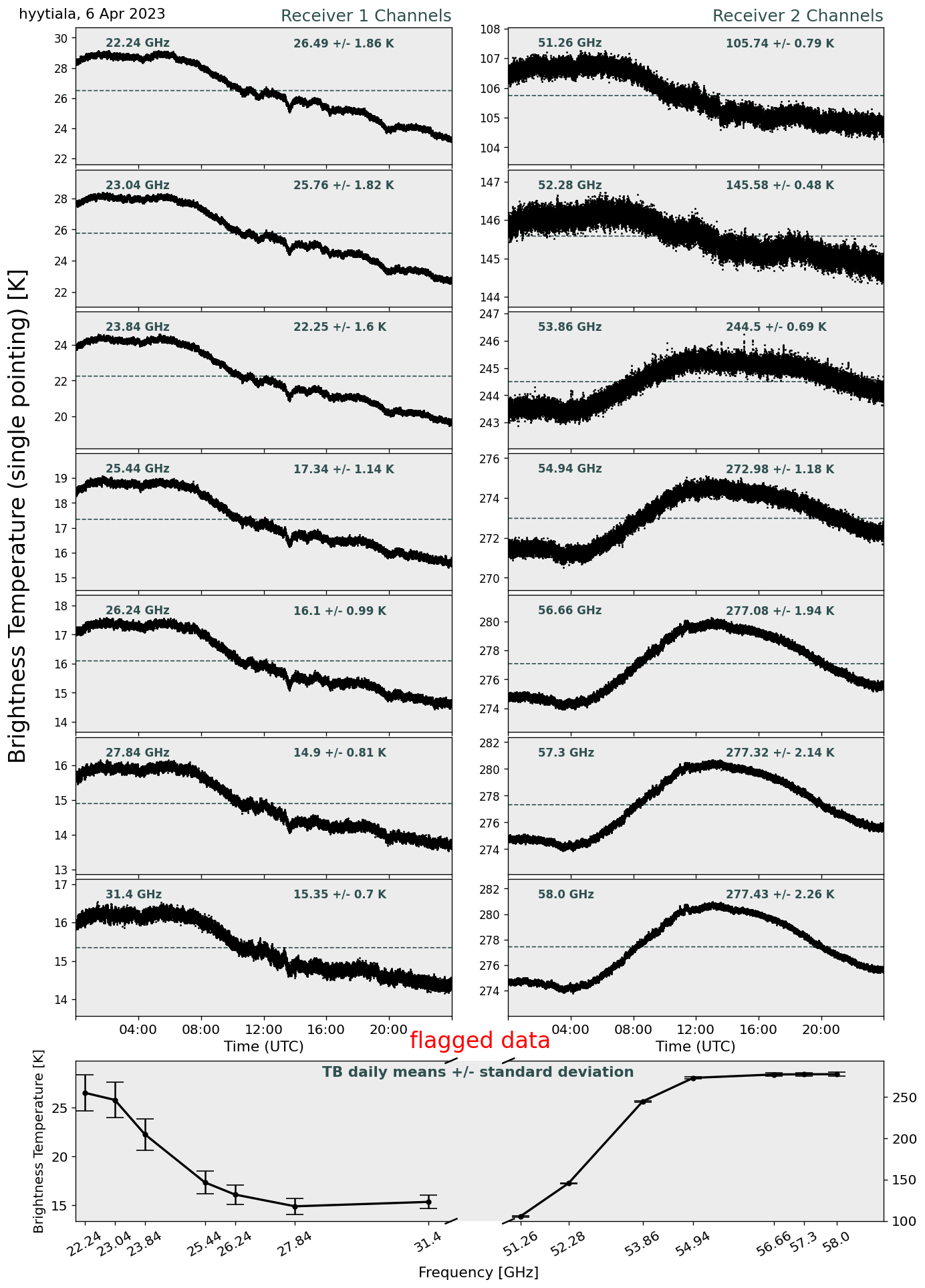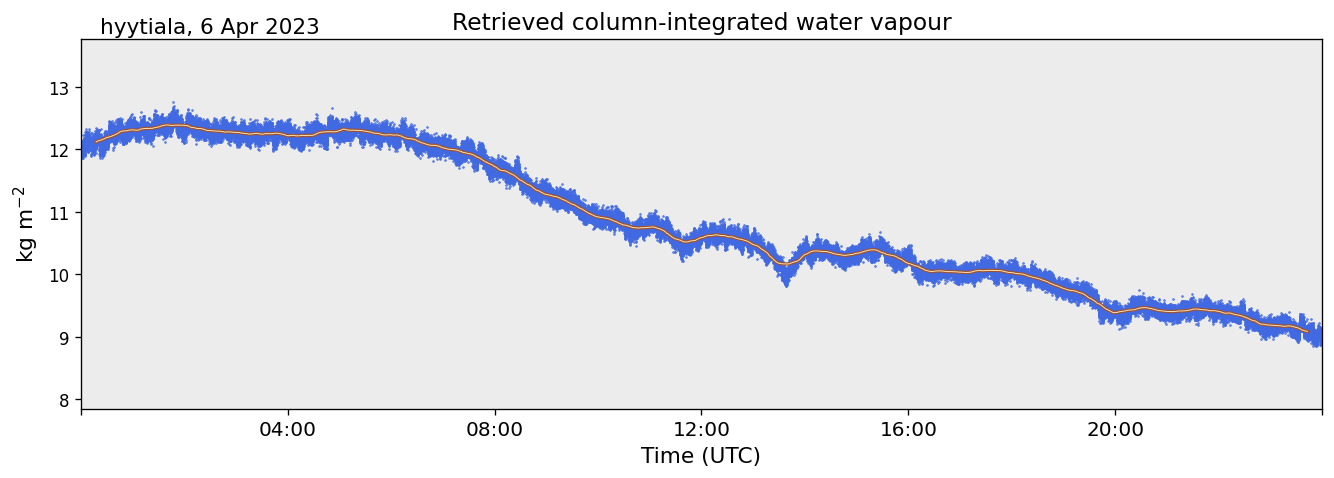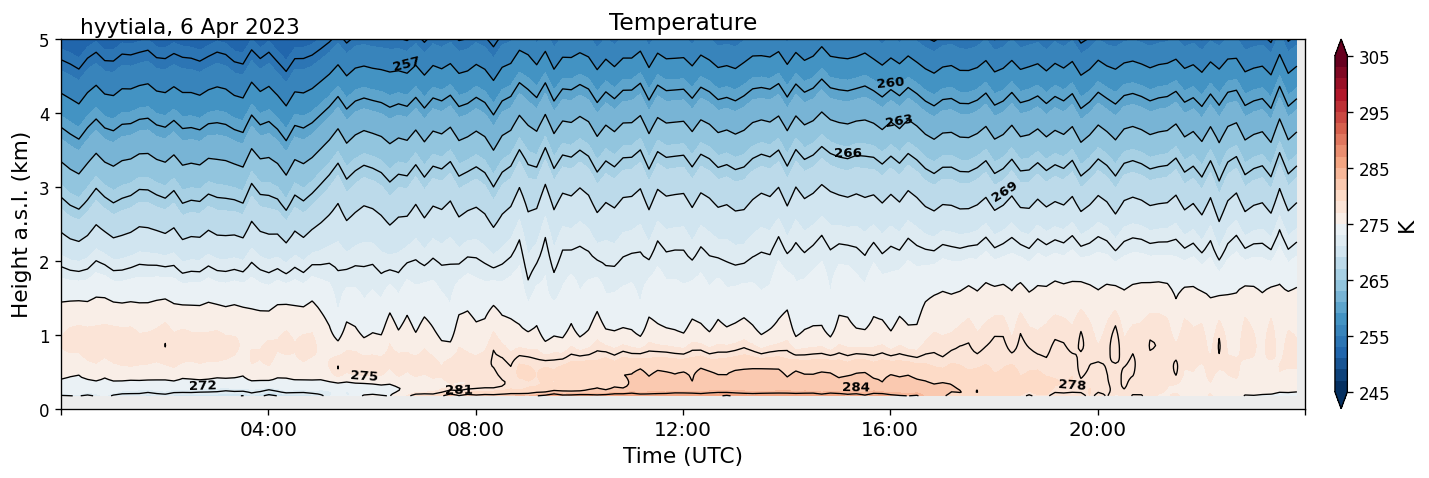MWRpy processing
In this tutorial MWRpy products are generated from raw data, including quality control and visualization. This example utilizes files taken from the ACTRIS site Hyytiala:
- RPG microwave radiometer:
Brightness temperatures: 230406.BRT
Housekeeping data: 230406.HKD
Elevation scans: 230406.BLB
Weather station: 230406.MET
Infrared radiometer: 230406.IRT
Note
.BRT and .HKD files are mandatory in MWRpy for processing
Level 1c
First we convert RPG microwave radiometer (MWR) binary files, including brightness temperature (TB) and housekeeping data (*.BRT, *.HKD), into a Level 1c netCDF file. Data from optional elevation scans (*.BLB, *.BLS), weather station (*.MET) and infrared radiometer (*.IRT) are combined in this process and the following quality flags are derived:
Bit 1: missing_tb
Bit 2: tb_below_threshold
Bit 3: tb_above_threshold
Bit 4: spectral_consistency_above_threshold
Bit 5: receiver_sanity_failed
Bit 6: rain_detected
Bit 7: sun_moon_in_beam
Quality flags are stored as bits and Bit 1-3 include checks for missing brightness temperature values and their valid
range (2.7 - 330 K). The spectral consistency flag (Bit 4) compares measured and retrieved TB. For this flag, it is
expected to have the corresponding RPG retrieval coefficient file (SPC*.RET) in
/mwrpy/site_config/{site}/coefficients/. Data from HKD files are used to determine the stability of the receiver
components (Bit 5). The sensor from the attached weather station detects rain for quality Bit 6 and the sun and moon
orbits are calculated and compared to the measurement geometry to detect potential interferences (Bit 7). A quality
flag status variable contains information whether the flag is active.
import os
from mwrpy.level1.write_lev1_nc import lev1_to_nc
SITE = "hyytiala"
PACKAGE_DIR = os.getcwd()
DATA_DIR = f"{PACKAGE_DIR}/tests/data/{SITE}"
mwr_raw = lev1_to_nc(
"1C01",
DATA_DIR,
site=SITE,
output_file="mwr_1c.nc",
)
The data format of the generated mwr_1c.nc file, including metadata information and variable names, is
compliant with the data structure and naming convention developed in the EUMETNET Profiling Programme
E-PROFILE.
Variables such as brightness temperature can be plotted from the newly generated file.
import os
from mwrpy.plots.generate_plots import generate_figure
PACKAGE_DIR = os.getcwd()
generate_figure('mwr_1c.nc', ['tb'], save_path=f"{PACKAGE_DIR}/")

Level 2 Single Pointing
Based on the Level 1c netCDF file mwr_1c.nc, MWR single pointing data are extracted
and product specific retrieval coefficients (LWP*.RET, IWV*.RET, TPT*.RET, HPT*.RET, STA*.RET)
are applied to generate the Level 2 single pointing product:
from mwrpy.level2.lev2_collocated import generate_lev2_single
mwr_prod = generate_lev2_single("hyytiala", "mwr_1c.nc", "mwr-single.nc")
Variables such as integrated water vapor (IWV) can be plotted from the newly generated file.
import os
from mwrpy.plots.generate_plots import generate_figure
PACKAGE_DIR = os.getcwd()
generate_figure('mwr-single.nc', ['iwv'], save_path=f"{PACKAGE_DIR}/")

Level 2 Multiple Pointing
Based on the Level 1c file, MWR multiple pointing data (elevation scans) are extracted
and product specific retrieval coefficients (TPB*.RET) are applied to generate the Level 2 multiple pointing
product:
from mwrpy.level2.lev2_collocated import generate_lev2_multi
mwr_prod = generate_lev2_multi("hyytiala", "mwr_1c.nc", "mwr-multi.nc")
Variables such as temperature profiles can be plotted from the newly generated file.
import os
from mwrpy.plots.generate_plots import generate_figure
PACKAGE_DIR = os.getcwd()
generate_figure('mwr-multi.nc', ['temperature'], save_path=f"{PACKAGE_DIR}/")

Command line usage
After defining the instrument type and site specific configuration files (including input/output data paths) in
mwrpy/site_config/, MWRpy can also be run using the command line tool mwrpy/cli.py:
mwrpy/cli.py [-h] -s SITE [-d YYYY-MM-DD] [--start YYYY-MM-DD]
[--stop YYYY-MM-DD] [-p ...] [{process,plot}]
Short |
Long |
Default |
Description |
|---|---|---|---|
-h |
–help |
Show help and exit. |
|
-s |
–site |
Site to process data from, e.g, hyytiala. Required. |
|
-d |
–date |
Single date to be processed. Alternatively, –start and –stop can be defined. |
|
–start |
current day - 1 |
Starting date. |
|
–stop |
current day |
Stopping date. |
|
-p |
–products |
1C01, single, multi |
Processed products, e.g, 1C01, 2I02, 2P03, single, see Data Types below. |
Command |
Description |
|---|---|
process |
Process data and generate plots (default). |
plot |
Only generate plots. |
no-plot |
Only generate products. |
reprocess |
Like process, but skips days when data processing fails. |
Data Types
Level 1
1B01: MWR brightness temperatures from .BRT and .BLB/.BLS files + retrieved spectrum
1B11: IR brightness temperatures from .IRT files
1B21: Weather station data from .MET files
1C01: Combined data type with time corresponding to 1B01
Level 2
2I01: Liquid water path (LWP)
2I02: Integrated water vapor (IWV)
2I06: Stability Indices
2P01: Temperature profiles from single-pointing observations
2P02: Temperature profiles from multiple-pointing observations
2P03: Absolute humidity profiles
2P04: Relative humidity profiles (derived from 2P01/2P02 + 2P03)
2P07: Potential temperature (derived from 2P01/2P02 + 2P03)
2P08: Equivalent potential temperature (derived from 2P01/2P02 + 2P03)
single: Single pointing data product (including 2I01, 2I02, 2I06, 2P01, 2P03, and derived products)
multi: Multiple pointing data product (including 2P02, and derived products)